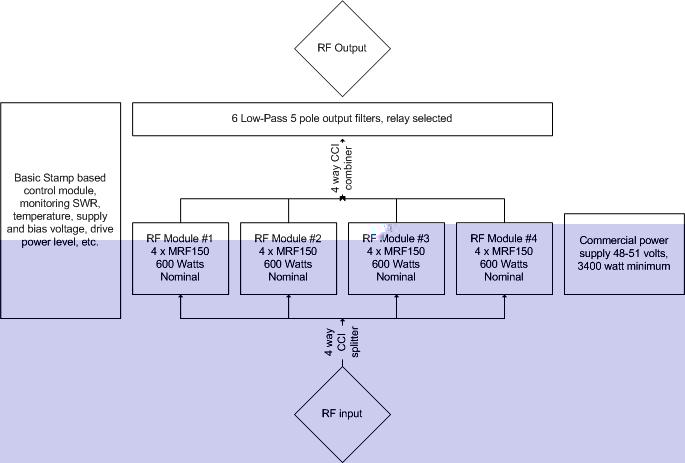|
|
THIS WEBSITE IS UNDER CONSTRUCTION! PLEASE EXCUSE OUR MESS.
This is a project to develop an "Open Source" reference design for a 1500 watt solid state linear amplifier for 10 through 160 meters. A draft requirements document is here - please comment in the discussion forum. A couple of years ago, I got interested in this subject. I operate a single operator, two radio (SO2R) amateur radio station optimized for contest use. In that station, I currently use two manually tuned tube amplifiers. To change bands, I have to retune an amplifier. Since the rest of my station is either already automated, or is rapidly becoming automated, this need to retune amps is becoming increasingly annoying. There are several obvious solutions to this problem. One is to simply buy two autotuning tube amps, either Acom 2000's or Alpha 87A's. The problem here is a simple one - money. These amps sell for about $6,000 new, and over $4,500 used in good condition. I simply don't have, and wouldn't spend on amps if I did have, that kind of money. The other obvious solution is a bank of six manually tuned tube amplifiers. I studied this question at some length a couple of years ago. It is a perfectly reasonable solution one the one hand. As it turns out, I already own four RF decks (for a variety of reasons). So I would only need two more. Even if I didn't have four already, a bank of six RF decks can be had for a reasonable price. After research I selected the Drake L-4B as the most likely suspect. These amps use a pair of 3-500Z's, and have a bandswitch and output tank that will handle 1500 watts of output. They were designed for 2000 watts PEP input however, and their power supply output voltage is too low for 1500 watts PEP output. That problem is simply solved by using an Ameritron AL-1200 for 160 meters (where the L-4B doesn't work anyway). The AL-1200's power supply puts out 3300 volts - perfect to drive the L-4B's to 1500 watts out. Since I only want to transmit with one amp at a time, I need low voltage supplies (heater and so forth) for each amp, but only one HV supply. Since the L-4B is already wired for an outboard HV supply, I would simply add an HV output to the AL-1200, and series connect the L-4B's to it. The problems with this scheme are various. First is physical space. 6 amplifiers would take more room than I have handy in my shack. Next is noise. 6 sets of fans... Next is the fact that a tube amp, even once tuned for a particular band, isn't really "tuned" forever. A change in antenna or a move from CW to phone can easily detune an L-4B enough to drop its output from 1500 watts to 1400 or even less. Not what I have in mind. Finally, there is the issue of parts. With 6 amps, something is going to break with unacceptable frequency. That means 10 3-500Z's, six blowers, lots of fuses - just too much to go wrong. Finally, there is the cost. By the time you buy 5 L-4B's and an AL-1200 and wire the whole thing up, you are into something like $5,000. Still a lot of money. So I started reading about solid state amplifiers. Like most others, I started with the Motorola application notes and engineering bulletins written back in the 70's and 80's by Helge Granberg. Then I started asking questions, on the Amps email reflector, of my club elmers like W2SC, and by email to helpful hams around the world. This web site chronicals my learnings about this topic, and my proposed reference design for a full output auto-tuning solid state amplifier suitable for contest use. My hope is that others following in my path will be able to use this reference design to build their own amps - or at least to travel the path more rapidly than I was able to. The problem, and this web site, can broken into pieces:
Here is the current proposed block diagram for the amplifier: An excellent overview article written by Helge can be found here . For general background, a nice article on the subject of tube vs. solid state amps can be found here N4IP's excellent write-up of his MRF157 amp project is here . WM5Z is also working on an amp, and his very nice site is here . Thanks to N6RK, we have the schematic for the Intech COM-1000 amplifer to review. |
